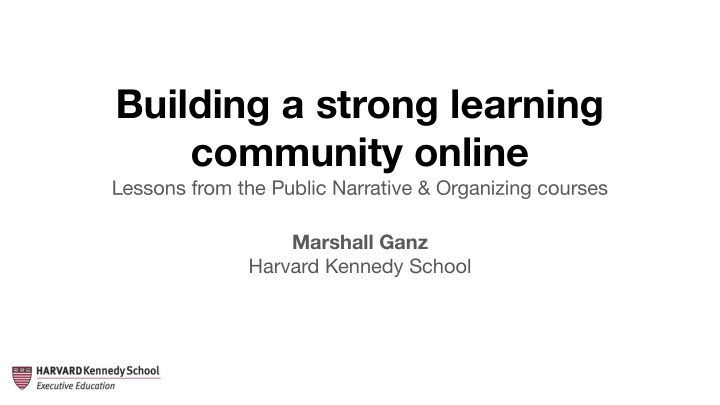



Building a strong learning community online Lessons from the Public Narrative & Organizing courses Marshall Ganz Harvard Kennedy School
Leadership & Public Narrative HKS Exec Ed, Fall 2019
What did we achieve? "Video conferencing technology is finally reaching a level of quality and consistency that makes it a great tool. As I previously mentioned, the highly structured facilitation (including use of section reps) was instrumental in making the distance format work. You might think that we'd feel more detachment from our peers since we're not in a room together. However, ironically, the fact that we see everyone's face all at once (especially in section) means we have more awareness of everyone paying attention and being present. "
What did it take to achieve that? 1. Preparation 2. Course Launching 3. Interactive Relational Pedagogy 4. Wrapping It Up
Preparation for Course Syllabus with assignments, readings, videos and tech platforms. Teaching Teams (possible configurations) An Instructor with tech know-how. An Instructor + Tech support person Our course had 1 Instructor, 2 Program Support Staff, 1 Head Teaching Fellow, 5 Teaching Fellows (TFs). Students with training in tech tools before course launch and commitment to entire course OR Facilitator with tech know-how
Course Flow for Students ASSIGNMENTS Readings, SECTION Written Cases Concepts, Case from LECTURE Presentation , experience, Explain, Model, Role Play, TF feedback Discussion Debrief Learning: +’s, ∆’s, Takeaways EVALUATION 5 page analytical paper.
Course Flow for Teaching Team TEACH PREP • Collect Takeaways, • Practice on call Pluses & Deltas about the Class • Role Play & Troll Play • Zoom recording & Slides Weekly Flow of • Disseminate materials Teaching • Assign Roles DEBRIEF • Collate Feedback from across sections • Your own Roses & Thorns
Launching the Course Relational Foundation One on One meetings between each student & TF Introductions by Team – Story of Self Brave Space & Norms To create a holding environment (for example, see next slide) Timed & Transparent Agenda Active and Intentional Facilitation
Example of Community Norms Explicit Norms/Norm Correction ❏ Growth mindset ❏ Respect time, including 5 minute tech check before class ❏ “Step up and step back” ❏ How to participate: raise hands visually or in participant box ❏ Keep Video On so we can see each other ❏
BUILDING AN ONLINE COMMUNITY: TEACHING
Structure of the Sessions ❏ Welcome ❏ Visuals: Slides, Charts, Maps ❏ Lecture/Discussion: Designated Students, Cold Calling, Open Discussion ❏ Polling ❏ The chat box ❏ Evaluations: pluses, deltas and key learning ❏ Sections (15-20 people): Student Presentations, Group Work in Breakout Rooms
Lecture Slides Slide Sharing View
Discussions: Section Reps Talia Puterman Brookline, USA Stacey Richards Andrew Kennedy St. Augustine, Mwavua Trinidad & Lindhurst, USA Tobago Noa Yammer Pei-Hsia Jerusalem, (Tammy) Israel Lai Taipei City, Taiwan
Discussions: Cheering on Chat!
Online Functions or Roles ⇼ Screen Sharer ⇼ Chat Monitor ⇼ Scribe for Slides (Could be a student) ⇼ Attendance Manager ⇼ Section Rep Coordinator ⇼ Tech Coordinator ⇼ Someone to pick who should speak ⇼ Poll Creator ⇼ Reminder-er ("starts in 1 hour! here's the link) ⇼ Post-lecture sharer (recording link, slides, chat, transcript)
Tips on Encouraging Participation in any medium ● Engaging quiet voices: setting norms from the beginning of the online learning community that encourages students to hold one another accountable for distributed participation. Norms such as “step up, step back” ● Balancing comfort with silence with comfort with cold calling and inviting students into conversation who look pensive but may not be speaking up ● Diverse learning tools: Including not only lecture, but small group work (breakouts), independent reflection, visuals, audiovisuals, polling, etc. ● Encouraging participation by giving quieter voices leadership roles within the lectures: timekeeping, scribing, etc. to help them see that they are a valuable member of the community
Value of Online Teaching ● Cross Contextual Learning: transcend geography & other boundaries ● Can see the faces of the whole class: emotional communication ● Requires paying attention, as offline activities are evident while video camera is on. ● Classes are recorded and transcribed ● Greater accessibility to multiple resources
Evaluations: Every Single Class + Dialogue was good. ● Sometimes it was hard Paul cases: people need to see ● ● Feedback was helpful to discern what we themselves in times of change. +1 were analyzing What story you create when ● Helpful that Micky read ● Good to have materials you go back to the old story. ● the narrative instead of ahead of time The leaders needs to ● looking at our emails champion and lead the ● Enjoyed the breakout ● change. They can’t delegate it rooms!!! to anyone else. The story of an us rooted in ● shared values is the cornerstone for successful change.
Evaluations: Mid & End of Course Survey
LECTURE PLUSES - QUALITATIVE “There were many strengths of the lectures. I think having a chance, especially in the second half of the course, to have more open discussion and ask questions was useful and helped learning. Marshall's explanations were really clear and helpful the vast majority of the time, and the videos were very helpful in clarifying concepts.” “The experience of Marshall, Sarah, and each TF resulted in a thorough curriculum, supported by in-depth, well developed , and thoroughly deliberate support materials, communications, and applicable germane readings & videos.” “Marshall’s experiences, lived moments of history, open supportive coaching, & pushing for growth, the technology that brought our global cohort into one lecture hall, the TFs, section reps., and in-depth discussions.” “Use of real-world examples, use of section reps to ensure participation by co-learners, use of chat to broaden the conversation and bring in questions from the wider group, consistency of format/timing (starting and ending on time).” “The videos were very very good examples and it added some sort of entertainment to the learning”
Celebration!
THANK YOU.
Recommend
More recommend